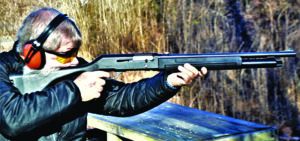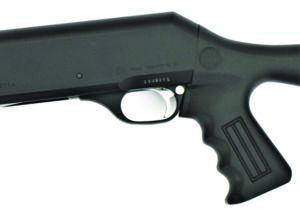GUN TESTS GRADE: B
$500
The Beretta 1201FP is a little-known shotgun in comparison to the Benelli M4 or other Benelli series. The standard 1201 and 1301 shotguns are more common than the 1201FP tested here. The Beretta 1201 features the Benelli inertia-drive-type action. With few moving parts and a promise of low maintenance, the inertia action has proven reliable and long in service. It is not perfect, however, as reports of problems arise if the shotgun is laden with accessories that might not be part of the original design envelope. The system and the shotguns that use this system have an excellent reputation for reliability. The Beretta appears to be an attempt at a more affordable version of the Benelli. The 1201 has been replaced by the 1301 shotgun. The 1201 was used by some agencies but never reached the popularity of the Benelli shotguns and is certainly outsold many times by pump shotguns. The Beretta 1301 is a gas-operated shotgun versus the inertia-type drive used by the Beretta 1201.
| Action Type | Semi-auto, inertia driven |
| Chamber Size | 3.0 in. |
| Overall Length | 42.0 in. |
| Capacity | 6+1 |
| Weight | 6.3 lbs. |
| Weight Loaded | 7.15 lbs. |
| Barrel Length | 20.0 in. |
| Receiver | Anodized black aluminum |
| Choke | Cylinder |
| Stock | Black synthetic |
| Stock Length of Pull | 13.8 in. |
| Stock Forend | Plastic |
| Front Sight | Post with brass bead |
| Rear Sight | V blade |
| Trigger Pull Weight | 5.0 lbs. |
| Safety | Crossbolt |
| Warranty | None, used |
| Telephone | (800) 237-3882 |
| Website | BerettaUSA.com |
| Made In | Italy |
The 1201FP features a blue finish on the receiver and barrel. The stock and forend are black synthetic. Our version was found used for the price we noted. In January 2020, we found three 1201s for sale at various sites from $500 to $569. These were straight-stock versions. Pricing and availability are much different now. The 1201FP tested is the less-common version with a pistol-grip stock. We really like this stock and feel that it offers an advantage in fast handling. The shotgun doesn’t feature the extended safety, cocking handle, or oversize bolt release of the more expensive shotguns. But we had no problem quickly manipulating the Beretta. It simply wasn’t as fast and slick as the others. The 20-inch barrel offers a good balance. The rear sight offers an open V for aiming, and the front sight isn’t a simple bead, but it isn’t a rifle sight either. But it is useful primarily with buckshot. The shotgun is much lighter than the other shotguns at 6 pounds and a few ounces. It isn’t a featherweight, but the lighter weight makes for faster handling.

During the firing test, the shotgun was reliable. We have no idea how many shells had been fired in the Beretta before we obtained it. The Beretta handles quickly and moves between targets smoothly. The problem is recoil. The Beretta, by virtue of its light weight, is a hard kicker. The self-loading action makes a difference compared to a pump, but this shotgun kicks more than a 7.5-pound pump action, in our estimation. Just the same, the shotgun was effective during the firing test when we fired the shotgun quickly. Control was not as good as with the other shotguns. The added recoil must be balanced against the Beretta 1201FP’s light weight and fast handling. For prolonged use, such as competition or for those who simply practice a lot, the Beretta will not be the top choice. As we handed the shotgun back and forth among the raters, all liked the Beretta as it came into the hand, but none liked being beat up from recoil. Still, if you are packing a heavy load over distance, such as hiking with a backpack, the 1201FP has merit.

When fired off the benchrest, the Beretta put an exclamation point on the shotgun’s recoil. Slugs struck just an inch and a half below point of aim on average, with an average group of 2.0 to 2.4 inches, very consistent across the board with the Hornady slugs, while the Fiocchi cut a 1.8-inch five-shot group and the Remington slugs, 2.35 inches. With no malfunctions and useful slug accuracy, the Beretta is a reliable and useful shotgun. The extended magazine holds six 2¾-inch shells, one more than the Benelli.
Our Team Said: There are several things that play against the Beretta as a viable choice. First, it is no longer in production and limited in availability. It is far less common, than, say, the Remington 870 shotgun. There is no provision for mounting a red-dot sight. Balanced against these demerits is the Beretta’s excellent reliability and fast handling. Performance is comparable to shotguns in the current Beretta/Benelli lineup that cost much more. Depending on the price tag, we would buy this shotgun and trust it.




























My 1201fp is a superb shotgun. Who fires a shotgun off a benchrest -absurd! Red dot sights – no.
I have shot clays with this gun and it is nothing short of awesome! The only thing I would change about it is to put some highly figured wood stocks on it. I would not sell it at any price. If you found one for sale, buy it!!!!!!!!!!!!!
Wow!! I bought my 1201 from a pawn shop for $300 back in 1997 and have had a fantastic time with it over the years. I was able to find a pistol grip for it in 2010 and it has made the world of difference for me for shooting clays. I see the 1301 and others and would not sell it at or trade it for any of the current lineup of shotguns. Im rocking my 1201 until it breaks!!!!